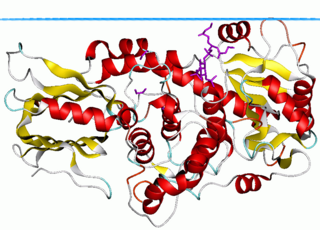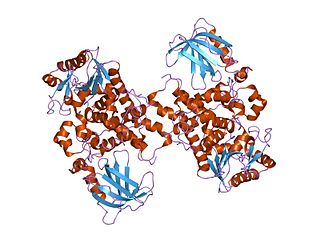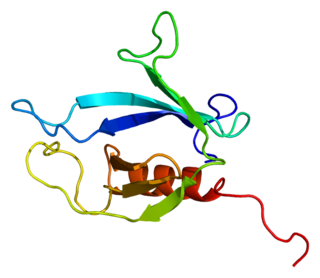Myotubularin-related protein 2 also known as phosphatidylinositol-3,5-bisphosphate 3-phosphatase or phosphatidylinositol-3-phosphate phosphatase is a protein that in humans is encoded by the MTMR2 gene. [5] [6] [7] [8]
Myotubularin-related protein 2 also known as phosphatidylinositol-3,5-bisphosphate 3-phosphatase or phosphatidylinositol-3-phosphate phosphatase is a protein that in humans is encoded by the MTMR2 gene. [5] [6] [7] [8]
This gene is a member of the myotubularin family and encodes a putative tyrosine phosphatase. The protein also contains a GRAM domain. [5] Mutations in this gene are a cause of Charcot-Marie-Tooth disease type 4B, an autosomal recessive demyelinating neuropathy. Multiple alternatively spliced transcript variants have been found, but the biological validity of some variants has not been determined. [8]
Phosphatidylinositol 3,5-bisphosphate is one of the seven phosphoinositides found in eukaryotic cell membranes. In quiescent cells, the PtdIns(3,5)P2 levels, typically quantified by HPLC, are the lowest amongst the constitutively present phosphoinositides. They are approximately 3 to 5-fold lower as compared to PtdIns3P and PtdIns5P levels, and more than 100-fold lower than the abundant PtdIns4P and PtdIns(4,5)P2. PtdIns(3,5)P2 was first reported to occur in mouse fibroblasts and budding yeast S. cerevisiae in 1997. In S. cerevisiae PtdIns(3,5)P2 levels increase dramatically during hyperosmotic shock. The response to hyperosmotic challenge is not conserved in most tested mammalian cells except for differentiated 3T3L1 adipocytes.

The GRAM domain is found in glucosyltransferases, myotubularins and other membrane-associated proteins. The structure of the GRAM domain is similar to that found in PH domains.

Myotubularin is a protein that in humans is encoded by the MTM1 gene.

Lipopolysaccharide-induced tumor necrosis factor-alpha factor is a protein that in humans is encoded by the LITAF gene.

Ganglioside-induced differentiation-associated protein 1 is a type of protein that in humans is encoded by the GDAP1 gene.

Periaxin is a protein that in humans is encoded by the PRX gene.

Myotubularin-related protein 3 is a protein that in humans is encoded by the MTMR3 gene.

Myotubularin domain represents a region within eukaryotic myotubularin-related proteins that is sometimes found with the GRAM domain InterPro: IPR004182. Myotubularin is a dual-specific lipid phosphatase that dephosphorylates phosphatidylinositol 3-phosphate and phosphatidylinositol (3,5)-bi-phosphate. Mutations in gene encoding myotubularin-related proteins have been associated with disease.

Myotubularin-related protein 6 is a protein that in humans is encoded by the MTMR6 gene.

Type I inositol-3,4-bisphosphate 4-phosphatase is an enzyme that in humans is encoded by the INPP4A gene.

SH3 domain and tetratricopeptide repeats-containing protein 2 is a protein that in humans is encoded by the SH3TC2 gene. It is believed to be expressed in the Schwann cells that wrap the myelin sheath around nerves.

Myotubularin-related protein 13 is a protein that in humans is encoded by the SBF2 gene.

Myotubularin-related protein 5 is a protein that in humans is encoded by the SBF1 gene.

Myotubularin-related protein 1 is a protein that in humans is encoded by the MTMR1 gene.

FYVE, RhoGEF and PH domain-containing protein 4 is a protein that in humans is encoded by the FGD4 gene.

Myotubularin related protein 14 also known as MTMR14 is a protein which in humans is encoded by the MTMR14 gene.
Phosphatidylinositol 5-phosphate (PtdIns5P) is a phosphoinositide, one of the phosphorylated derivatives of phosphatidylinositol (PtdIns), that are well-established membrane-anchored regulatory molecules. Phosphoinositides participate in signaling events that control cytoskeletal dynamics, intracellular membrane trafficking, cell proliferation and many other cellular functions. Generally, phosphoinositides transduce signals by recruiting specific phosphoinositide-binding proteins to intracellular membranes.

Polyphosphoinositide phosphatase also known as phosphatidylinositol 3,5-bisphosphate 5-phosphatase or SAC domain-containing protein 3 (Sac3) is an enzyme that in humans is encoded by the FIG4 gene. Fig4 is an abbreviation for Factor-Induced Gene.

Protein VAC14 homolog, also known as ArPIKfyve, is a protein that in humans is encoded by the VAC14 gene.

Myotubularin related protein 12 is a protein that in humans is encoded by the MTMR12 gene.